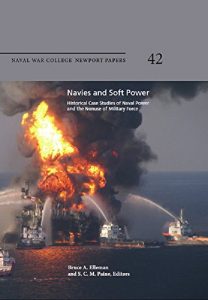This book is the last in a series of seven collections of case studies over the past twelve years that have examined the institutional roles played by navies throughout history. This final volume, edited by Bruce A. Elleman and S. C. M. Paine, expands the series to cover the use of navies as instruments of “soft power,” which includes a wide variety of missions. The use of navies for purposes other than war is a phenomenon that goes back to antiquity and has continued ever since. For example, the great historian and keen observer of res navales Thucydides was well aware of the importance of ancient Greek antipiracy operations for promoting wealth and security. Perhaps one of the most interesting cases from antiquity is the humanitarian mission led by Pliny the Elder in AD 79, when, as commander of the Roman fleet at Misenum, he went to Pompeii to rescue civilians imperiled by the eruption of Mount Vesuvius, losing his life in the process.
Navies have thus always carried out a variety of operations that went beyond those necessary for the fighting and winning of wars and they continue to do so. During the last two centuries the U.S. Navy has engaged in an ever-broader array of non-warfighting missions. For example, the Navy was famously involved protecting against piracy in the Mediterranean in the early nineteenth century and carried out equally important patrol missions, such as attempts to stop the illegal slave trade beginning in the mid-nineteenth century. After the end of the Cold War, many other nonmilitary missions came to the fore, in particular maritime humanitarian aid missions after natural or man-made disasters. One recent example of such a mission was the post-tsunami Operation Unified Assistance in Southeast Asia during 2004–2005. Beginning in 2006, the U.S. Naval War College was engaged in the process of writing the Navy’s latest strategy document, called A Cooperative Strategy for 21st Century Sea Power. This document was published in October 2007, and updated in March 2015.
While the Cooperative Strategy has a strong focus on traditional missions, embedded in concepts such as deterrence, sea control, and power projection, it also discusses broader missions such as maritime security and humanitarian assistance/disaster relief. Its the latter two missions that form the current volume's focus, which examines nine vs the Newport papers case studies from the nineteenth through the twenty-first century on a wide spectrum of non-war-fighting missions.
Navies have thus always carried out a variety of operations that went beyond those necessary for the fighting and winning of wars and they continue to do so. During the last two centuries the U.S. Navy has engaged in an ever-broader array of non-warfighting missions. For example, the Navy was famously involved protecting against piracy in the Mediterranean in the early nineteenth century and carried out equally important patrol missions, such as attempts to stop the illegal slave trade beginning in the mid-nineteenth century. After the end of the Cold War, many other nonmilitary missions came to the fore, in particular maritime humanitarian aid missions after natural or man-made disasters. One recent example of such a mission was the post-tsunami Operation Unified Assistance in Southeast Asia during 2004–2005. Beginning in 2006, the U.S. Naval War College was engaged in the process of writing the Navy’s latest strategy document, called A Cooperative Strategy for 21st Century Sea Power. This document was published in October 2007, and updated in March 2015.
While the Cooperative Strategy has a strong focus on traditional missions, embedded in concepts such as deterrence, sea control, and power projection, it also discusses broader missions such as maritime security and humanitarian assistance/disaster relief. Its the latter two missions that form the current volume's focus, which examines nine vs the Newport papers case studies from the nineteenth through the twenty-first century on a wide spectrum of non-war-fighting missions.












